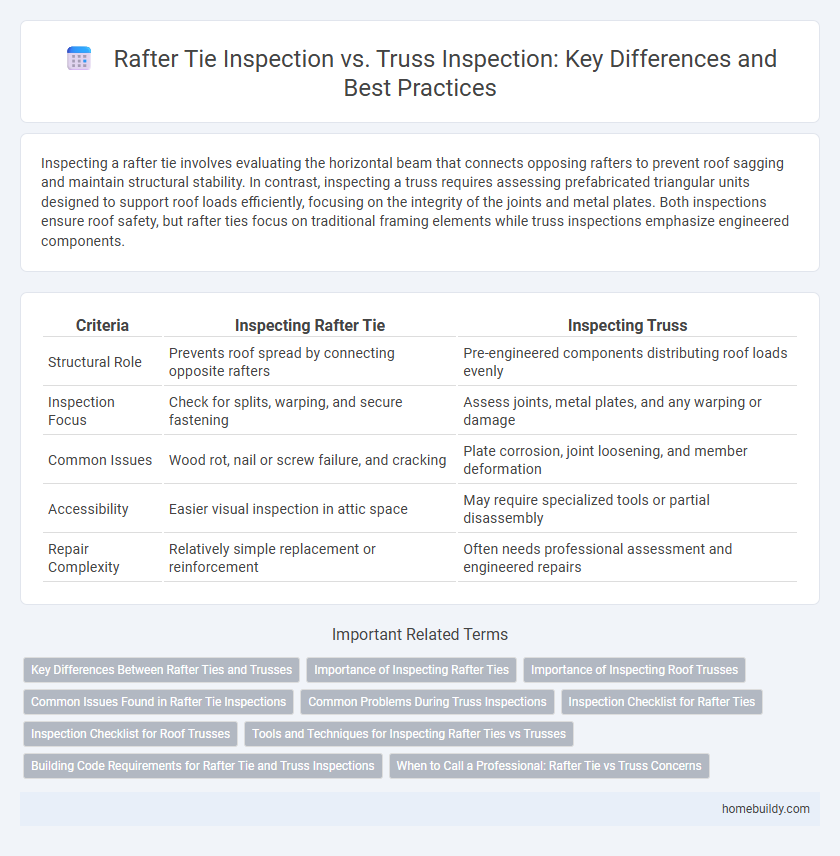Inspecting a rafter tie involves evaluating the horizontal beam that connects opposing rafters to prevent roof sagging and maintain structural stability. In contrast, inspecting a truss requires assessing prefabricated triangular units designed to support roof loads efficiently, focusing on the integrity of the joints and metal plates. Both inspections ensure roof safety, but rafter ties focus on traditional framing elements while truss inspections emphasize engineered components.
Table of Comparison
| Criteria | Inspecting Rafter Tie | Inspecting Truss |
|---|---|---|
| Structural Role | Prevents roof spread by connecting opposite rafters | Pre-engineered components distributing roof loads evenly |
| Inspection Focus | Check for splits, warping, and secure fastening | Assess joints, metal plates, and any warping or damage |
| Common Issues | Wood rot, nail or screw failure, and cracking | Plate corrosion, joint loosening, and member deformation |
| Accessibility | Easier visual inspection in attic space | May require specialized tools or partial disassembly |
| Repair Complexity | Relatively simple replacement or reinforcement | Often needs professional assessment and engineered repairs |
Key Differences Between Rafter Ties and Trusses
Inspecting rafter ties involves evaluating horizontal members that provide lateral support by connecting opposing rafters, preventing roof spreading, and maintaining structural integrity in traditional roof framing. Truss inspections focus on prefabricated, triangulated wood or metal components designed to distribute loads evenly across the roof structure, often bearing both vertical and lateral loads. Key differences lie in rafter ties being individual elements resisting outward thrust, while trusses are complete engineered systems with interconnected members optimized for load distribution and strength.
Importance of Inspecting Rafter Ties
Inspecting rafter ties is crucial for maintaining roof structural integrity as they prevent the outward spread of rafters and ensure load distribution across the framework. Unlike trusses, which are factory-built and engineered for uniform strength, rafter ties must be regularly checked for warping, cracking, or separation to avoid roof sagging or collapse. Proper inspection detects early signs of damage or weakness, preserving the connection between opposing rafters and safeguarding the overall stability of traditional roof systems.
Importance of Inspecting Roof Trusses
Inspecting roof trusses is essential for maintaining structural integrity and preventing potential roof failures, as trusses distribute loads evenly across the roof framework. Unlike rafter ties, which provide lateral support to rafters, trusses are engineered components combining multiple members to optimize load-bearing capacity and resist deformation. Regular inspections of roof trusses ensure early detection of issues such as wood rot, joint separation, or metal connector corrosion that can compromise the entire roofing system's stability.
Common Issues Found in Rafter Tie Inspections
Rafter tie inspections frequently reveal issues such as wood rot, improper fastening, and insufficient sizing, which compromise structural integrity. In contrast, truss inspections often identify problems like metal connector corrosion, joint separation, and manufacturing defects. Understanding these common defects in rafter ties is essential for targeted maintenance and ensuring roof stability.
Common Problems During Truss Inspections
Common problems during truss inspections include wood splitting, corrosion of metal connectors, and improper load distribution, which can compromise structural integrity. Rafter tie inspections often emphasize checking for adequate nailing, signs of sagging, and proper attachment to prevent roof racking. Identifying these issues early during truss and rafter tie inspections helps maintain roof stability and prevents costly repairs.
Inspection Checklist for Rafter Ties
A thorough inspection of rafter ties includes checking for metal connectors' corrosion, verifying proper nailing patterns, and ensuring no visible cracks or splits in the wood that compromise the tie's load-bearing capacity. Inspecting trusses focuses on joint integrity, member alignment, and signs of deflection or damage from moisture or pests. The rafter tie inspection checklist emphasizes structural connection security and material condition to maintain roof stability.
Inspection Checklist for Roof Trusses
Inspecting roof trusses requires a detailed checklist focusing on connection integrity, metal plate conditions, and the absence of splits or warping in wooden members. Rafter tie inspections emphasize checking the horizontal tension members for secure fastening, straightness, and signs of wood decay or damage. A comprehensive roof truss inspection ensures load distribution is uncompromised, while rafter tie inspections verify the prevention of outward wall spreading in traditional roof framing.
Tools and Techniques for Inspecting Rafter Ties vs Trusses
Effective inspection of rafter ties involves using moisture meters, inspection mirrors, and pry bars to detect signs of wood decay, warping, or loose connections in accessible attic spaces. In contrast, truss inspections often require structural engineering tools such as laser levels, tension gauges, and sometimes drone technology for visualizing complex roof systems from various angles. Both methods emphasize precise measurement and visual assessment, but truss inspections generally demand more advanced equipment due to their engineered design and load distribution features.
Building Code Requirements for Rafter Tie and Truss Inspections
Building codes require rafter tie inspections to ensure lateral stability and prevent roof spreading, typically specified in residential framing standards like the International Residential Code (IRC). Truss inspections follow the prescriptive requirements in the International Building Code (IBC) and include verifying manufacturer specifications, bracing, and load path integrity. Both inspection types mandate structural compliance, but truss inspections emphasize engineered component certification while rafter tie inspections prioritize proper nailing and placement for effective force distribution.
When to Call a Professional: Rafter Tie vs Truss Concerns
Signs of compromised rafter ties include visible cracks, sagging, or separation at the joint, which can lead to roof instability and require immediate professional evaluation. Truss inspections should focus on detecting damaged metal connector plates, warping, or split wood members, as these defects can critically affect structural integrity and pose safety risks. Homeowners suspecting issues in either rafter ties or trusses should promptly contact a qualified structural engineer or licensed contractor to ensure accurate diagnosis and safe remediation.
Inspecting rafter tie vs Inspecting truss Infographic

 homebuildy.com
homebuildy.com